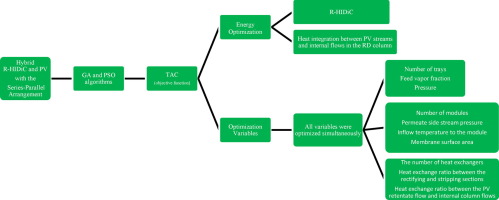Separation and Purification Technology ( IF 8.1 ) Pub Date : 2020-03-02 , DOI: 10.1016/j.seppur.2020.116786 Omid Babaie , Mohsen Nasr Esfahany

|
Tert–amyl methyl ether (TAME) production process is consisted of a reactor, a reactive distillation (RD) column and the methanol recovery section. The bottom product of the RD column is TAME while the distillate is consisted of the azeotropic mixture of methanol and isopentane (i-pentane) that can be separated by either the pervaporation (PV) membrane or conventional pressure swing distillation (PSD) and extractive distillation (ED) methods. The PV process allows the use of both series and parallel arrangements. The series arrangement has a lower membrane area compared to the parallel arrangement, while the parallel arrangement has a lower energy cost. A series–parallel arrangement with recycle streams was used in the present study to take advantage of both the series and parallel arrangements. The HIDiC method was used for reducing energy consumption in the RD column. Moreover, heat integration between PV streams and internal flows in the RD column was used to reduce PV energy consumption. The number of modules in each row, the recycle stream, the heat exchange ratio between the rectifying and stripping sections in the RD column and the heat exchange ratio between PV streams and internal RD streams were obtained by a hybrid GA–PSO algorithm. Furthermore, all RD and PV parameters were considered optimization variables and most importantly, all process variables were optimized simultaneously. According to the results, the proposed process reduced the total annual cost (TAC) by 52% and led to a 57% energetic gain compared to the conventional hybrid RD–PSD process. The proposed process also reduced TAC by 48% and led to a 40% energetic gain in comparison with the hybrid RD–PV process. This can be related to the reduced membrane area compared to the series and parallel arrangements as well as reduced energy costs of PV heaters through heat integration between PV steams and internal flows of the column.
中文翻译:

混合R–HIDiC–PV工艺的优化和热集成,以及用于TAME生产的PV组件和循环流的串联-并联布置
叔戊基甲基醚(TAME)的生产过程由反应器,反应蒸馏(RD)柱和甲醇回收段组成。RD塔的底部产物为TAME,而馏出液则由甲醇和异戊烷(异戊烷)的共沸混合物组成,可通过全蒸发(PV)膜或常规变压蒸馏(PSD)和萃取蒸馏将其分离(ED)方法。PV工艺允许同时使用串联和并联布置。与并联布置相比,串联布置具有较小的膜面积,而并联布置具有较低的能量成本。在本研究中,采用了具有循环流的串联-并联布置,以充分利用串联和并联布置。HIDiC方法用于减少RD色谱柱的能耗。此外,利用RD塔中PV流和内部流之间的热集成来减少PV能耗。通过混合GA-PSO算法获得了每行中的模块数量,循环流,RD塔中精馏段和汽提段之间的热交换率以及PV流和内部RD流之间的热交换率。此外,所有RD和PV参数均被视为优化变量,最重要的是,所有过程变量均被同时优化。根据结果,与常规的混合RD-PSD混合工艺相比,拟议的工艺将总年度成本(TAC)降低了52%,并带来了57%的能源收益。与RD-PV混合工艺相比,拟议的工艺还将TAC降低了48%,并带来了40%的能量增益。与串联和并联布置相比,这可能与减少的膜面积有关,也可能与通过PV蒸汽和色谱柱内部流之间的热集成降低了PV加热器的能源成本有关。











































 京公网安备 11010802027423号
京公网安备 11010802027423号